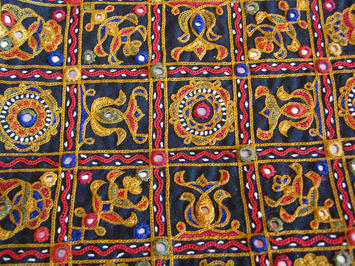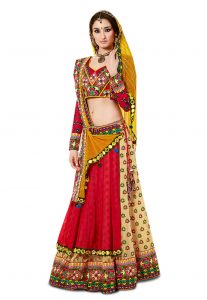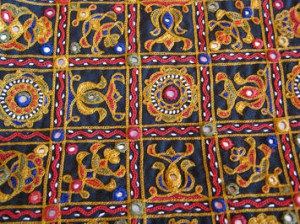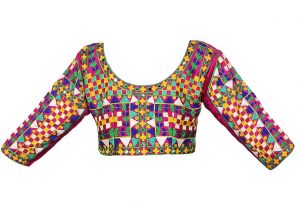
Abla Embroidery
Effervescent and a true reflection of the Indian spirit is the mirror work, or what is popularly known as ‘Kutch’ or ‘Abla’ embroidery which originated in Gujarat. This kind of embroidery is one in which round pieces of mirror are decorated on fabrics like cotton and chiffon using buttonhole stitching. Silk thread is used in several colors like light green, indigo, dark red and colors of pink. The craftsmen use a large variety of stitches to decorate several objects. It represents the Gujarati tradition, in particular the aura of festivity and joy. The mirrors come in several sizes and can be used on dupattas, sarees, lehengas, and blouses.
Origin & History
If we make a list of Indian states that truly represent the Indian culture, Gujarat most certainly figures in the top 5 states of India. It is enriched with a diverse, unique, cultural and conventional past, which it firmly holds on to inspite of rapid commercialization and development. Sheesha, which means mirror, and in other words Abla embroidery, originated in the 17th century. When it first came into existence, this kind of needlework was done using mica, but gradually the artisans used glass which was blown into small pieces for this kind of work. This concept initially took birth in Iran during the Mughal period. Shisheh is a Persian term for glass, and over the years it became popular in India, especially in Gujarat, Rajasthan, Haryana, Delhi, and several other states. This kind of embroidery is most commonly found in clothes, wall hangings, and several other household decorations. Apart from decorative purposes, Abla embroidery also has religious significance, in particular for Muslims and Jains who use ‘Shisha torana’, which is a wallhanging tied to the front door and gets rid of the evil eyes.
Current Scenario
What was once a mere hobby or interest for the natives of Gujarat has now become a part of the larger picture of what showcases Indian artisanship and culture. By tradition, mirror embroidery was stitched by women living in the villages, who would make clothes for their families and other decorations in order to celebrate various Gujarati festivals, and to honour their gods. It was created out of interest and devotion, and not for money-making or profit. However, mirror work today is not restricted to rural landscapes and settings; it has found its way into the urban fashion hub as well, and makes style statements not only on clothes, but on household decorations and furniture as well. With Indian designs creating a craze all over the world, mirror work is part and parcel of what is considered unique and up-to-the-minute for all the fashion gurus.
Artisans Behind the Fabric
This Art developed mainly in the 16th and 17th Century, in a small town of Gujarat called Patan. Over the years however, this skill has become more commercialized. What makes the desolate land of Kutch come alive is the vibrancy and liveliness represented through the Abla embroidery.
Gujarati women adorn their beautiful craftsmanship and have no qualms in displaying their style for everyone to see and adore. Also, because of this art gaining more popularity and business, it has inspired the people in Gujarat to master their skill and come up with all kinds of innovations and designs. The landscape of Gujarat, the heart of the Gujarati people is what reflects in the designs sewn onto the various objects like ghagra, cholis, bedspreads, bags, wall hangings and cushion covers.
Diversity in Design
Abla embroidery is vast in its designs and style. Some of these examples include rabari, paako, suf, garasia jat, bhanusali, khareek and ahir. All these different styles represent the different Gujarati tribes, and their lives. The mirror work is a true reflection of their thoughts, and what holds them together as a community. The different designs and techniques in each style is what eventually bring together the diversity and individuality of the Gujarati community.
Innovations
Mirror work has become a popular element in what defines Indian fashion, and several designers, over the years, have used this style to display many of their designs. New age Indian designers like Abraham & Thakore have used mirror work and have given it a modern twist which embodies the Indian ethnicity while giving it the extra edge and oomph factor on the runways. Payal Singhal, who specializes in ethnic luxury wear, has created some exotic Indian creations using Abla embroidery. This kind of embroidery brings out the fun factor in any dress, whether it is ethnic Indian or western wear. The small or big mirror details help in giving any attire personality, which may be regarded as fun and chic at the same time.
Global Wear
The fun element that mirror work brings to any attire makes it worth the wear to any occasion. Since Indian fashion designers have used this type of embroidery in their contemporary designs, it has also gained popularity in western wear, and one can see mirror embellishments on Nehru jackets, shrugs, wraparounds, dupattas, etc. The scope to which this embroidery can be used is endless.
Wearing the Attire
One needs to accessorize depending on the type of outfit. If it is a cotton dress, then one can wear some Black Metal or Junk earrings or bracelets. If it is a saree with elaborate mirror work, then one needs to be minimalist in terms of jewelry. Teaming it up with simple makeup and lighter accessories is the best, as the design itself does the glamour-oriented role exclusively.
Mirror work is not something that is considered ‘over the top’ or dressy. It has a casual and vibrant effect, which is also elegant at the same time. It can make a simple kurta look chic and trendy, and a saree look more colorful with its pulsating designs. Silver or copper toned jewelry goes best with these designs. Heavy mirror work dupattas teamed with plain cotton kurti or kurta can give a sophisticated look.

Resham & Mirror Work Lehenga
Maintenance
Maintaining your precious mirror work attire is just another challenge. However, one has to be careful while washing them since too vigorous a procedure may ruin the mirrors or displace them from the stitch work. Also, while retaining them in your cupboard, assure that the cloth is not exposed to any dampness, else the glasses often lose their and go black.
Interesting Facts About Abla embroidery
- Abla embroidery is native to Gujarat
- Fashion designers have used Abla to give concluding touches to their garments, and are a rather new occurrence in the fashion industry
- Originally mica was used for such designs, but then later actual mirror was incorporated
- This embroidery is found not only on Indian garments but is also used on beaded handbags and Indian handicrafts
References
Categories: Motifs & Embroideries


